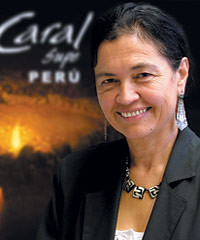Caral: Ruth Shady Solís
 She was a girl who belonged to the Archaeology Club in her school and found it a great influence in her life, so much so that she is now a Doctor in Archaeology and the woman in charge at the special Caral-Supe project. It took 13 years to demonstrate to the world that the city of Caral, located on the Peruvian coast, developed in line with the civilisations as old as those of Egypt or India.
She was a girl who belonged to the Archaeology Club in her school and found it a great influence in her life, so much so that she is now a Doctor in Archaeology and the woman in charge at the special Caral-Supe project. It took 13 years to demonstrate to the world that the city of Caral, located on the Peruvian coast, developed in line with the civilisations as old as those of Egypt or India.
What do we know of Caral and especially of its inhabitants?
It was a society very differentiated, with people very well feed and others not. They were about 1.77m (5”6’) in height. These were strong men and their food was primarily from the ocean. Through various studies we have also verified that the people of Caral had long hair full of dredds in the lower parts.
How did you begin your relationship with this ancient city?
In 1978, when I was already a professional and was investigation in the Valle de Huaura, they invited me to see the lands of what was the Chupacigarro hacienda. It was in this time that I learnt of Caral. In 1994 I visited for the first time the Valle de Supe, for me this was a place I knew I must visit. Until that moment there weren’t any systematic excavations that were able to securely fix, with certainty, what the time of construction of the monuments was and what time it was inhabited.
What was it that indicated that there was something to discover?
In the eyes of an archaeologist, to find a settlement with mounds, with distinct formations, that is an indication. We are accustomed to recognise monuments even when they look like hills.
And what did the people say about your ideas?
They didn’t believe me. One time a geologist said to me: “How can this be a pyramid? It’s obvious it’s just a hill”. He stubbornly insisted that the monument could not be a pyramid. No-one believed what I was saying.
And how did the work of the investigation begin?
I spoke with the principle of the University of San Marcos about this, and presented a plan for a program of investigation in Caral. I also spoke with the director of the Instituto Nacional de Cultura (INC) and with the mayors. There was really a shared interest to help investigative work in the valley. The investigators that were in Supe before never imagined that in front of them were the testimonies of the oldest civilisation in the Americas.
When as it proven that it was the oldest civilisation?
After the first few months of the excavation, in 1996. I noticed that there was no ceramics though there were monuments. This was a society without ceramics but with interlaced textiles which are a sign of a more advanced civilisation.
How was the reaction from the academic world?
Negative. People didn’t like that it changed what they thought of history, and much less that a woman changed it. The comments were that it was a society with ceramics but not pre-ceramics.
In that what were they trying to say?
That the society at Caral was backward, that while all other societies produced ceramics they didn’t. I said to them: “This can’t be, if this is a backwards society how were they able to build these massive constructions?”
It had been 13 years of hard work, not only to be able to demonstrate the age of Caral, the abilities of the society but also for acceptance. First it had been recognised by foreign colleagues and later by my colleagues here.
Carbon tests eventually proved the age?
In 2001 we had the first datings from the labs in the US and Germany. Actually, we have 42 datings and all show that Caral was occupied from 3000B.C.
Speaking again of you, how were you able to carry forward such a tremendous project?
I persevere and when I believe in something I fight to the end for it.
And you define yourself…
As a person that since childhood had a strong passion for archaeology.
Was it difficult to study archaeology in the 1970s, being a woman?
My friends said to me that as an archaeologist I would be dying of hunger. Because of my financial situation, I signed up in the faculty for night classes. In the day I did archaeology and in the night my education. I completed both.
How was your passion for archaeology born?
I don’t know, all I can say is that my father gave me books about history. He was very interested in the history of Peru, he was a foreigner – a Czech. I read so much and in school I joined the Archaeology Club. From a very young age I went to museums or to archaeological sites as a member of this club.
Related blogs:
– Introduction to Caral
– Caral: The oldest civilisation in the Americas
Tags: Archaeology, caral, ruth shady










